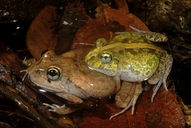|
Distribution and Habitat
Country distribution from AmphibiaWeb's database: Australia
Along the northern and eastern sections of Australia. From the Kimberley zone in Western
Australia, across northern Northern Territory, northern and south-eastern Queensland and into
the central coast of New South Wales. The extent of occurrence of the species is approximately 2,244,000 km2.
Life History, Abundance, Activity, and Special Behaviors
Found in many habitats that are subject to seasonal inundation. Often found in dry sandy
watercourses some distance from permanent water. They burrow in the daytime and may
spend the dry season in a dormant state well beneath the surface.
Breeds in the wet season only after heavy rain. Males call whilst floating in the water, which may
be only a small puddle. Females lay about 1000 eggs in a foam nest that collapses after a few
hours to form a floating layer up to 7cm across. Females may breed more than once each
season.
Trends and Threats
No known declines and large extent of occurrence.
Threats
None known.
Conservation Measures
None in place.
Comments
This species was highlighted in News of the Week, 29 March 2021:
Amphibians stand apart from all other vertebrates in their great range of genome sizes. They are largest in the salamanders, where genomes are huge (over 100 gigabases), but genomes of some frogs enter the salamander range and can be quite large (the largest reported is for the myobatrachid Arenophryne rotunda). Caecilians are somewhat intermediate. The smallest amphibian genomes are also found in myobatrachid frogs. Lamichhaney et al. (2021) reports on the genome of Platyplectrum ornatum, a small burrowing frog from Australia with a very small genome -- 1.05 Gb, like that of birds. Transposable elements (TE) account for much of the extreme growth of amphibian genomes, but here all major classes of TE are reduced. Keeping TE's in check appears to be a key to genome miniaturization, and it may be driven by convergence in life history in small genomed species, in particular rapid and flexible tadpole developmental time and carnivorous tadpoles. Phylogenetic analysis shows that the genome is evolutionarily reduced rather than being a primary feature of this taxon. (David Wake)
References
Barker, J., Grigg, G. C., and Tyler, M. J. (1995). A Field Guide to Australian Frogs. Surrey Beatty and Sons, New South Wales.
Margules, C.R., Davies, K.F., Meyers, J.A., and Milkovits, G.A. (1995). ''The responses of some selected arthropods and the frog Crinia signifera to habitat fragmentation.'' Conserving Biodiversity: Threats and Solutions. Surrey Beatty and Sons, Sydney, 94-103.
Originally submitted by: Jean-Marc Hero et. al. (first posted 2002-04-05)
Edited by: Ambika Sopory (2021-04-04)Species Account Citation: AmphibiaWeb 2021 Platyplectrum ornatum: Ornate Burrowing Frog <https://amphibiaweb.org/species/3509> University of California, Berkeley, CA, USA. Accessed May 27, 2025.
Feedback or comments about this page.
Citation: AmphibiaWeb. 2025. <https://amphibiaweb.org> University of California, Berkeley, CA, USA. Accessed 27 May 2025.
AmphibiaWeb's policy on data use.
|
